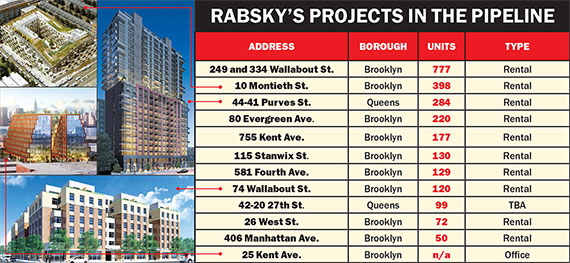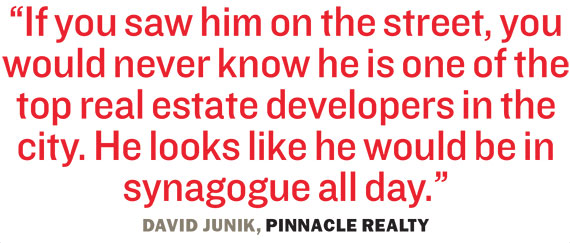Trending
The Rabsky riddle
Firm head Simon Dushinsky is building more Brooklyn apartments than almost anyone, but public sightings are still rare

As the face of Brooklyn rapidly changes, the face of one of its most prolific developers remains shrouded in shadows.
Real estate professionals have long relied upon LLCs and tight-lipped lawyers to shield them from public view. But few are as inconspicuous as Simon Dushinsky, who runs the Williamsburg-based Rabsky Group with his partner, Isaac Rabinowitz.
The duo, who melded their names to come up with the Rabsky Group moniker, run their mini development empire out of a 10-person office at 505 Flushing Avenue. They have never talked to the press, and photos of them are all but impossible to come by.
Yet the company has nearly 1,850 units in the pipeline in Brooklyn, making it one of the most active developers in the borough, and almost 400 more to boot in Queens, according to applications filed with the city.
At the moment, the firm’s two biggest projects are a 398-unit Bushwick rental building, which is part of Read Property Group’s 10-building Rheingold Brewery redevelopment, and a proposed 777-unit rental complex on the former Pfizer site at the edge of Bedford-Stuyvesant.
Despite the substantial mark Dushinsky is making in Brooklyn, he is virtually unknown in the real estate world on the other side of the East River.
“It’s a very insular community over in Brooklyn,” said the Marketing Directors’ Andrew Gerringer, who said he has struggled to get Dushinsky on the phone for more than a year. “Most people in Manhattan real estate do not know him.” (Incidentally, The Real Deal tried Dushinsky more than a dozen times and made attempts to contact him through numerous third parties, to no avail.)
Developers and brokers who have met and worked with Dushinsky, the dealmaker behind the firm, describe him as shrewd, hands-on and well respected. They also immediately note that he is adamant about his privacy, and rarely discusses his personal life.
“Simon and his partner are modest and low-key in everything that they do,” said David Korn, president of Fiddler Realty, which handled leasing for the 188-unit Leonard Pointe rental that Rabsky opened late last year, among other rental buildings. “They don’t boast about themselves. Simon feels he doesn’t gain anything from it.”
Simon Dushinsky stands in sharp contrast to the corporate developer types like the Related Companies or Silverstein Properties, with their sleek offices and sophisticated public relations operations.
His office sits on the ground floor of a seven-story condo building that he developed for the Hasidic community, to which he belongs. Rabsky has no website detailing its portfolio of buildings and under-construction projects, and not a single photo of Dushinsky exists online.
According to sources close to him, Dushinsky is in his mid-40s, was born and raised in Israel and lives in the Vizhnitz Hasidic community in Williamsburg. He is married with seven children, has a long black beard and payos, and wears a traditional frock coat, sources told TRD.
And rather than power-breakfasting or lunching at the Four Seasons like many Manhattan real estate players do, he integrates daily prayer into his schedule, sometimes attending synagogue before work and Talmudic study sessions at the private school Yeshiva Tzemach Tzadik Viznitz in the evening.
“If you saw him on the street, you would never know he is one of the top real estate developers in the city,” said David Junik, partner at Pinnacle Realty, which brokered Rabsky’s $32.2 million purchase of 44-41 Purves Street in Queens in 2013. “He looks like he would be in synagogue all day.”
And yet, his projects are popping up in a spate of new neighborhoods in the city’s hottest borough.
Architect Karl Fischer — who has designed a number of Rabsky’s projects since 2002, when they teamed up on the $40 million, six-building Park Plaza condo complex for Hasidic residents — said Dushinsky is the dealmaker of the Rabsky duo.
Rabinowitz, he said, is more focused on the creative process, often looking at architectural plans and suggesting design ideas. Dushinsky, he said, usually calls him with the block and lot numbers of a site he’s eyeing, and says, “ ‘Tell me what I can do on this site.’ ”
Their conversations are tinged with humor and often take place at the architect’s office, and can last for hours, with Dushinsky quick to crack a joke, Fischer said.
“He questions architects quite a lot, about how to squeeze the most out of his projects,” said Fischer, noting that Dushinsky pushes him to maximize the floor area ratio as much as possible. But Fischer is not the only architect Rabsky has tapped.
At the Rheingold Brewery site and another in Long Island City, Rabsky is working with Eran Chen’s architecture firm ODA New York and opting for a more innovative design. Rabsky’s proposed building at 10 Montieth Street is expected to feature a 25,000-square-foot zigzagging landscaped roof for biking, running and gardening.
Chen said Dushinsky is a “progressive thinker” who is seeking to attract a new generation of young renters to Bushwick, a neighborhood historically lacking in recreational space.
“We consider ourselves experts in zoning and were blown away by his vast knowledge of zoning and building code regulations,” said Chen.
Beyond Hasidic developments
The Rabsky Group launched in the early 1990s and started out developing condos for the Hasidic community.
A deal with the Chetrit Group strengthened Rabsky’s foothold in the broader Williamsburg market.
In 2002, the Chetrit Group acquired more than a dozen industrial buildings in the neighborhood at a bankruptcy auction, according to court filings. Sources told TRD that Rabsky, which was more familiar with the neighborhood than Chetrit, might have been a silent partner at some of those buildings. While that could not be confirmed, and Chetrit could not be reached for comment, Rabsky paid $4 million for a 50 percent stake in six of the buildings in 2007, property records show. Dushinsky developed one of the properties into the 113-unit rental, the Driggs, in 2011. He sold off or redeveloped the other buildings into rentals.
And that’s just a portion of a slew of Rabsky’s deals in the last five years. While big development firms like Two Trees Development and Hudson Companies have been long established on the Brooklyn scene, Rabsky is among a batch of developers — along with Adam America and Yoel Goldman — to emerge in a forceful way in the Brooklyn market since 2012.
Earlier in his career, Dushinsky appears to have pooled together investment money from friends and relatives in his community. But with larger projects come larger loans and more institutional sources of financing.
In January, for example, Rabsky secured a $95 million mortgage from TD Bank to refinance its debt at Leonard Pointe. Other lenders include Bank Leumi, based in Israel, and BBVA Compass, a subsidiary of Banco Bilbao Vizcaya Argentaria, based in Spain.
Real estate players said Dushinsky possesses the financial means and business savvy to turn around projects and flip properties at a fast pace.
“Simon has the ability to capture the market momentum and buy quickly,” said Ofer Cohen, CEO of Brooklyn-based commercial firm TerraCRG, which is working with Rabsky on two pending deals. “He’s working with much of his own money and can move faster, with confidence, independence and capital behind him.”
Rabsky, for example, bought a three-story former silverware factory at 51 Jay Street in Dumbo for $25 million in 2012. The next year, it secured Landmarks Preservation Commission approval for a one-story addition as part of a proposed residential conversion, and then sold the building to Silverstone Property Group for $45.5 million. Martin Nussbaum and David Schwartz, who left Silverstone to form Slate Property Group, are now developing it into 73 condo units and a townhouse with Adam America.
Sean Kelly, managing director at CPEX Real Estate, confirmed his decisive nature. He said last fall he showed Dushinsky a Park Slope assemblage, and less than a day later, the developer agreed to buy.
“You usually get a ‘yes’ or ‘no’ very quickly,” Kelly said. “He looked at the zoning and the numbers, and he was committed.”
Getting visible
While Dushinsky can sometimes seem like a ghost, he is not entirely off the radar.
While it’s been a while, back in 2005 and 2006, he doled out political contributions to Queens Democrat Melinda Katz, as well as to Brooklyn Democrat David Yassky and former City Council Speaker Gifford Miller in their bids for public office.

And though Rabsky has largely steered clear of legal disputes, in 2005, Dushinsky, Rabinowitz and another equity partner, Aaron Jacobowitz, were named in a lawsuit by a Chapter 7 bankruptcy trustee. The trustee alleged that between 1998 and 2003, they fraudulently diverted “tens of millions of dollars” from the public pharmaceutical distributor Allou Healthcare, which was headed by the Jacobowitz family, to fund their Park Plaza project.
The majority of the claims were dismissed in bankruptcy court in 2007.
Separately, Jacobowitz, who controlled multiple LLCs for the bankrupt Allou, was among eight people indicted as part of a $177 million fraud scheme and was sentenced to 10 years in prison in 2007 for money laundering. (Jacobowitz is due for release in June.)
But there have been no suits against Rabsky since.
Sources note that as Rabsky takes on bigger projects, it will have no choice but to become more visible. Along with the widening scope of its developments, the firm is gradually stepping outside of its comfort zone in both the neighborhoods it’s building in and the type of projects it’s pursuing.
“His path became a lot more strategic as he got bigger, following the growth of up-and-coming neighborhoods,” said TerraCRG’s Cohen.
Dushinsky would rather be in a solid market and overpay than make a deal in uncharted territory, sources said.
In 2013, Rabsky looked toward Long Island City for building a 44-story, 415-unit residential tower at 39-32 Northern Boulevard. In a span of five months, the firm bought a two-story building on the site for $35 million, then sold it for $53.3 million to Simon Baron Development, which sought to carry out the plans.
Now Rabsky is back with plans for two other projects in the neighborhood: a 25-story, 284-unit rental building at 44-41 Purves Street and a 15-story, 99-unit building at 42-20 27th Street that will likely be rental.
And in a departure from its residential-heavy portfolio, Rabsky is partnering with Toby Moskovits’ Heritage Equity Partners on a 400,000-square-foot office building at 25 Kent Avenue in Williamsburg.
As Rabsky’s footprint grows, Dushinsky is expected to become even more of a force in the market and possibly make a move into Manhattan.
“I don’t think he’s married to Brooklyn or Queens,” Pinnacle’s Junik said. “For him, it’s all about opportunity. If he finds the right opportunity, he’ll make a move.”




